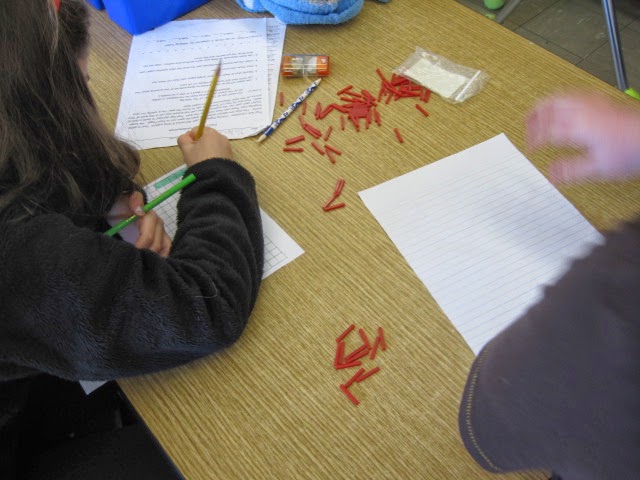Students completed work on Peggy's Piglet Pandemonium
and then gathered around two posters to
and then gathered around two posters to
discuss similarities and differences.
All possible chicken rehabilitation pens.
All possible piglet pens.
All possible chicken rehabilitation pens.
Below is what the board looked liked when the students ended the discussion.
There were many, many connections, ideas, thoughts, etc., but only a few are on
the board. Third graders did a great job explaining their thinking and reasoning.
What students noticed:
"The rectangles start out tall and skinny and get wider and shorter."
"The greater the perimeter, the more possible
rectangular pens you can make."
"The piglet's pen has more possible rectangles because
it has 4 more feet of fencing."
“'Janet's Chicken Rehabilitation' problem ends with a pen
“'Janet's Chicken Rehabilitation' problem ends with a pen
that is 5’ X 5’ and there are 5 possible rectangular play spaces.
'Peggy's Piglet’s Pandemonium' problem ends with a pen that
is 6’ X 6’ and there are 6 possible rectangular play spaces.”
is 6’ X 6’ and there are 6 possible rectangular play spaces.”
"The 1' X 9' and the 1' X 11' pens have the least amount of
square feet and the square pens have the most square feet."
Students then wondered...
“Would using any number of feet for the perimeter
always end with a square pen?”
Eliot's conjecture: "I think the number of feet of fencing
would have to be a multiple of 4.
Students decided to test these hypotheses.
They got busy, this time using linear pieces to
represent feet and then recording the results on
centimeter graph paper.
Findings!
Teams
|
Perimeter in Feet
|
Did it end in a
Square?
|
Dimensions of end rectangle
(also greatest area) |
Number of possible
rectangles
|
Nora and
John
|
12
|
Yes
|
3’ X 3’
|
3
|
*
Aidan's Play Space
|
20
|
Yes
|
5’ X 5’
|
5
|
Jack and
Naomi
|
22
|
No
|
5’ X 6’
|
5
|
*
Peggy's Pig
Pandemonium
|
24
|
Yes
|
6’ X 6’
|
6
|
Eli and
Eliot
|
28
|
Yes
|
7’ X 7’
|
7
|
Paige and
Carter
|
30
|
No
|
7’ X 8’
|
7
|
Nora and
John
|
36
|
Yes
|
9’ X 9’
|
9
|
* These two had already been done by all
students.
More student
comments:
“The rectangle
with the greatest area (for each perimeter) has at least one dimension that matches
the number of possible rectangles.”
“The perimeter
must be a multiple of 4 to have a rectangle that is a square.” (A square is a
special type of rectangle.)
Third graders
could go on and on with this math problem. They did some great thinking
and reasoning throughout these math sessions.









No comments:
Post a Comment